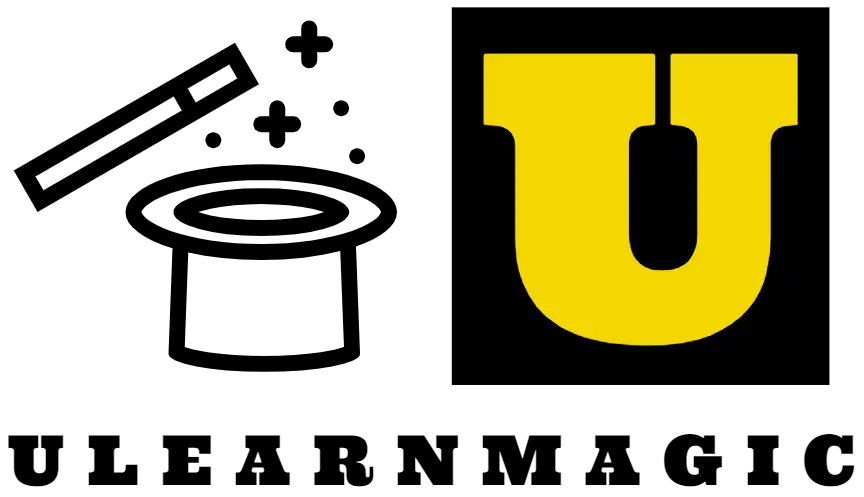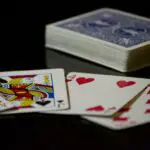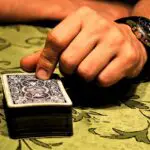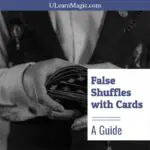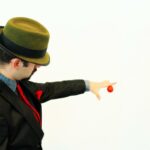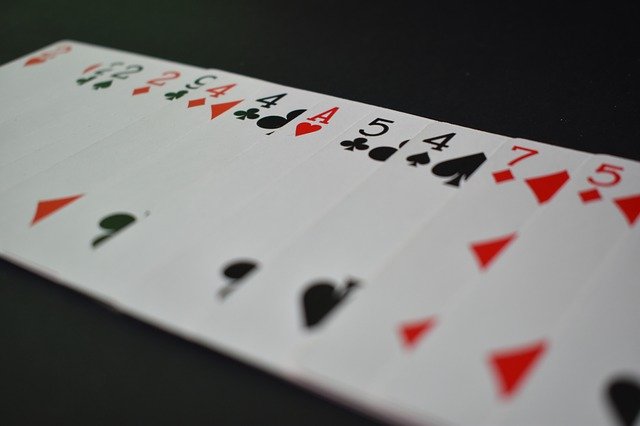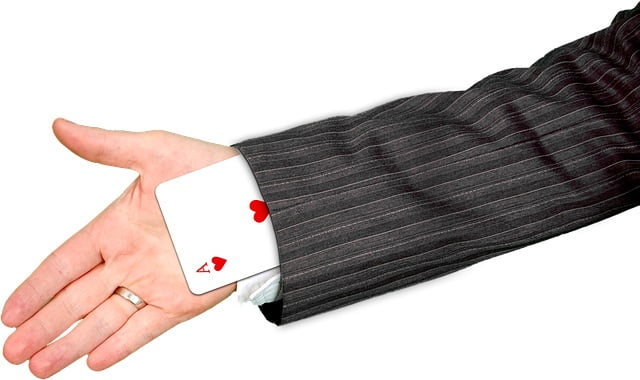
If you are interested in learning sleight of hand for card magic, then this will be a great resource for you! In this post, I would like to share with you the best card sleights, which ones you should learn, and how to apply all of them.
Furthermore, I’ll break the sleights down into different categories so you can understand them better.
Let’s get started!
What is Card Sleight of Hand?
Sleight of hand is a term for moves in magic that require dexterity and skill. These are hidden moves that are meant to be unseen during the performance.
The result of the sleight of hand creates a magic effect, or what appears to be magic to the audience. Most magic tricks are dependent on sleight of hand to accomplish the effect.
In magic, there are many types of magic that can be performed. Card magic is one type of magic.
Each type of magic has its own set of sleights. So card magic has its own sleights that are used to perform card tricks.
See more at What is Sleight of Hand?
This video will show you some sleight of hand card magic, and what is possible.
The Basics of Card Sleights
Card sleights can be broken down into a couple of different categories, or at least this is the way I look at it. An interesting fact is that most card sleights originated from the gambling table, and were moves used to cheat at gambling with cards. So a lot of these sleights will be related to gambling moves and originated as gambling moves.
The categories are as follows:
- False Shuffles
- False Cuts
- Controls
- Turnovers and Lifts
- Passes
- Forces
- Palming
- False Counts
- False Deals
- Color Changes
- Flourishes
- Card Manipulation
That’s a lot, so let’s break all those down next!
(These videos demonstrate some of the sleights mentioned and are quite impressive.)
False Shuffles
False shuffles are one of the most commonly used sleights in card magic. They are pretty essential to most sleight of hand card tricks.
(For a more in-depth look at false shuffles, see the post False Shuffles with Cards – A Guide (With Tutorials)
A false shuffle is a shuffling of the cards that looks like a real shuffle, but in reality, some or all of the cards are not actually shuffled, even though it appears as if they were. This is the first of the moves that originated from the gambling table.
False shuffles are important in card magic for two reasons. First, a lot of card tricks will require a setup or a stack.
This means that you set the cards in a particular order before the trick. Or you have one or more cards set up in a particular part of the deck. The magic trick is dependent on this particular setup.
When you do a false shuffle before the trick, you give the appearance that you are actually mixing the cards, but in reality, you are not. So the audience does not suspect that you have a deck that is set up ahead of time. It just looks like you shuffled a deck.
The second reason why false shuffles are important is that they can give the illusion that you are losing the spectator’s chosen card, or cards, in the deck by mixing the deck.
This is a common plot in card magic. A spectator or spectators select one or more cards, and the cards are placed back in the deck, seemingly lost by shuffling, and then magically found again.
The false shuffle gives the illusion that the cards are being mixed, when in fact the chosen card or cards remain where they need to be.
False shuffles can vary in difficulty, and it depends usually on how many of the cards are remaining in the same position. You have full deck false shuffles, bottom stock false shuffles, and top stock false shuffles.
Full-deck false shuffles are the hardest to master and perform. These keep the entire deck in the same exact order. Some of the greatest card magicians, ones who handle cards well and usually perform gambling demonstrations, such as Darwin Ortiz, usually have a very good and convincing full deck false shuffle.
Top stock false shuffles are easier and keep one or more cards on the top of the deck in the same order and on top of the deck. Bottom stock false shuffles do the same except they keep the bottom cards in the same order and on the bottom of the deck.
Here’s my easiest false shuffle tutorial.
Here are ways to retain just the top card, which is the easiest way to falsely shuffle cards.
(Or watch Easy False Shuffles to Retain the Top Card Only on YouTube here)
False Cuts
False cuts are very similar to false shuffles. And they basically have the same purpose as well. These also originated from the gambling table.
The only difference is that instead of falsely shuffling the cards, you are falsely cutting the deck. The cut, just like the shuffle, is a classic move in card games in order to mix the cards. Usually, in a card game, several shuffles will be followed by a cut.
A lot of times in magic you can follow the same sequence. Maybe a false shuffle or two, followed by a false cut. The false cut at the end further gives the appearance that the cards are completely mixed and you could not know where any of the cards might be in the deck.
Also, if you are not very good at false shuffle sleights, especially full deck false shuffles which can be the hardest, you might choose to just do a false cut or two instead of any false shuffling of the cards. This could still give a slight appearance that the cards are mixed.
If you are going to do just a false cut and not a shuffle, Jay Ose, a gambling magician, had the best false cut. It’s a triple cut called the Jay Ose false cut.
Card Controls
Card controls are another very essential sleight in card magic. So many card tricks are based on controlling one or more cards. In fact, I would say that the vast majority are.
A card control is a move in which a card, or multiple cards, will be controlled to a certain location of the deck. This location is usually the top of the deck, but could also be the bottom, depending on the trick. This is another move from the gambling table, in which a needed card, such as an Ace, would be controlled to the top of the deck or where needed.
The card control is used in almost every card magic trick in which the magician asks the spectator to select a card and return it to the deck. The card control allows the magician to keep control of that card and move it to the top or bottom of the deck. This is all while seeming to lose the card somewhere in the middle of the deck.
There are probably more card controls than any other sleight in card magic. The number of different card controls is numerous. The right one really just depends on the circumstances and what works best for you. Although, some are more convincing than others.
Here below is the easiest card control I know. It may be even easier than the Double Undercut. You can find the full post for it at Easiest Card Control (Alternative to the Classic Pass – The Mahatma Pass).
(Or watch Easiest Card Control & Classic Pass Alternative on YouTube here)
The Double Turnover and Double Lift
The Double Turnover or the Double Lift is another very frequently used sleight in card magic. Although the names are sometimes used interchangeably, they are actually two slightly different moves.
But for the most part, what you are doing is turning two cards, or showing two cards, as one card. That’s the essence of the Double Turnover. The move is done so that two cards are turned over on top of the deck, but because they are stuck together, and because it’s almost impossible to tell the difference between the thickness of one card versus two cards, the two cards appear as one card.
The Double Turnover is almost always incorrectly referred to as the Double Lift.
The actual Double Lift is the same idea, except that instead of turning the cards over on top of the deck, as with the Double Turnover, instead you are lifting two cards off the deck and showing them as one card (while still in your hand).
This can be used to give the appearance that a different card is on top of the deck than what actually is. Or, it can be used to show a card, seemingly the top card, then turn it over and deal it down or turn it back over again, and it will have changed into another card.
Here is my easiest double-lift for beginners to use. You can see the full post and learn more at Easiest Double Lift in Card Magic! (Great for Beginners).
Card Passes
The idea of the pass is another idea that comes from the gambling world. A pass is basically a way of cutting the deck, but invisibly and without suspicion. This could be used as a card control, and a lot of times is by professionals.
But, it is more than just a control, it can be used for other effects as well. A pass could even be used as a Color Change.
There are numerous types of passes. But, the most popular type of pass is the Classic Pass. This is also probably the hardest pass to do. This is a move that could take months just to be able to execute. And then years in order to perfect and make it invisible.
But, there are some professional magicians who are mentalists and do poor versions of the Classic Pass, yet get away with it. This is because the audience does not know what to look for. Also, they might be good at misdirection.
If you are looking to make the Classic Pass invisible, here is my tutorial on that.
If you are very good at the Classic Pass, here is my tutorial on using the Classic Pass as a Color Change!
There is an interesting move that doesn’t fall into the usual categories of card magic. However, a pass is openly done in front of the spectators and the deck is cut, but it is done in an invisible manner.
It’s called the Prophecy Move and you can learn more about it at Easiest Sleight In Card Magic! (Bill Simon Prophecy Move)
This move can also be done to force two cards (the top and bottom cards of the deck). We will cover forces next.
Card Forces
Card forces in card magic are a way of forcing a spectator to choose a particular card, even though they feel like they have a free choice of a random card.
There are many different types of forces available to the card magician. Each one can suit the situation, the trick, and the skill level of the magician.
One of the hardest forces is the classic force, yet it is the most believable force. It seems as if the spectator truly had a free choice of any card. (Generally the harder forces will require more skill)
One of the easiest forces, and one taught in most beginner magic books, is the cross cut force. It also requires no sleight of hand but does require some misdirection.
Here is an easy card force that I teach that is an alternative to the cross cut force, and uses no sleight of hand.
Card Palming
Palming cards is another sleight that came from the card table. To palm a card means to hold it securely in the palm of your hand so that it can’t be seen or known that you are holding a card.
There are a few different ways to palm a card, but not nearly as many different sleights as seen in card controls or false shuffles. The most popular method of card palming is the classic palm.
The first reason to use card palming is to remove a card secretly from the deck. This card usually comes from either the top or bottom of the deck in the most commonly used palms. The famous and classic card tricks, Card to Pocket and Card to Wallet, both use a card palm as the sleight of hand move to accomplish the magical effect of the card transporting to the magician’s pocket or wallet.
The second use for a card palm is to add cards to the deck by secretly holding them out. The spectator can then shuffle a deck completely, and a card can still be controlled by adding it to the top or bottom of the deck with the palm.
There are also a couple of other palms such as the back palm and Tenkai palm which are used more often in Card Manipulation, but also sometimes to conceal a card.
Here’s a demonstration of palming and what it can look like and accomplish.
False Counts
False card counts are usually used in packet card tricks. Packet card tricks are card tricks that involve only a couple of the cards, rather than the entire deck. But there are some tricks in which false counts are used with the entire deck as well.
The most common count for packet tricks is the Elmsley Count. The Elmsley Count was made famous by card magician Alex Elmsley. The Elmsley Count is a way of counting four cards as more in full view, but hiding one of the cards so it’s not seen in the count. So many great tricks involve the Elmsley Count. It’s worth learning.
Another count which is similar to the Elmsley Count, but not used as often, is the Jordan Count. Occasionally you will see tricks that use the Jordan Count, so you may need to learn it as well. But, the Elmsley Count is used far more often.
Another sleight involving a false count is one in which the cards are miscounted. That is, a packet of cards is made to look like they have more cards than there actually are. This is useful for the classic trick, Cards Across. (Or see Cards Across Download at MJM Magic)
Here’s a trick involving some false counts.
False Deals
The moves are straight from the old gambling moves. False deals are not seen a lot in card magic though. I include them because they do exist and you will see them on occasion.
One of the most common false deals is the Second Deal, in which the second card of the deck is dealt, but it looks like the top card was.
Another popular false deal is the bottom deal. In this, the bottom card of the deck is dealt, but it looks like the top card was dealt instead.
Color Changes
Color changes can be a whole lot of fun. Color changes are any kind of visual change of a playing card. Some good color changes can look like real magic!
There are also lots and lots of color changes out there. Just as there are lots of false shuffles and controls, there may be just as many color changes as well.
Combined with a good control, and maybe a false shuffle, doing a color change can be a magic trick in itself! And it’s visual and simple, which people usually like.
The Snap Change is probably my favorite color change. It was invented by Ed Marlo, so you know that it’s a classic in card magic!
Here is the classic snap change as a card trick.
Here is my favorite card trick using the snap change, where a card appears to jump out of the deck into your hand.
If you are good at the Classic Pass, here is my tutorial on using it as a color change.
Card Flourishes
This is an interesting category, but I wanted to add them here. Card flourishes are not the typically hidden sleight of hand moves that make a card trick happen. In fact, card flourishes are done openly, and not in secret at all. But, people still like them and they can look really cool and magical.
Professional magicians routinely will use card flourishes, and they can really add to the value of a trick. In fact, some of the most popular card magic books will actually start out teaching card flourishes such as the ribbon spread. These flourishes make you look more elegant with cards, and are just much nicer than randomly spreading cards in a mess. So they are important to learn and master.
I consider card flourishes to be sleight of hand in a sense. This is because they take a great deal of dexterity and practice. Some of the most popular card flourishes include the one-handed cut, the scissor cut, a card fan, the card spring, the ribbon spread, and the Sybil cut.
There is a modern-day rise in popularity with what is called Cardistry, which is basically nothing but advanced card flourishes and routines based solely on these advanced flourishes.
Card Manipulation
Card Manipulation is a category of card magic that requires great dexterity and skill. Card Manipulation is usually done in a stage setting. However, there are some performers who will perform these on the streets.
Card Manipulation is usually pure sleight of hand. It is very visual and usually, the effect is that of cards disappearing and reappearing.
There are other kinds of manipulation effects as well. Some of these include throwing and spinning cards, and what looks like juggling of cards.
Jeff McBride is a master of Manipulation, including Card Manipulation. He’s made his living in Vegas doing shows for decades involving advanced Card Manipulation.
He also teaches younger magicians at his school where Card Manipulation is taught. You can find Jeff McBride’s Manipulation teachings here.
Here’s a card manipulation trick where you vanish a card. You can learn more about it at Learn to Vanish a Playing Card in Thin Air! (The Vanishing Card Trick)
Common Questions
Who Are the Best Sleight of Hand Card Magicians?
Here are some great sleight of hand card magicians that I think are wonderful to learn from, and quite impressive to watch!
Lennart Green
Watching Lennart Green is just simply amazing. He is an expert.
Dani DaOrtiz
Darwin Ortiz
Juan Tamariz
The famous Spanish magician, well known for his Mnemonica Stack.
How Do You Get Better at Sleight of Hand with Cards?
You get better at sleight of hand with cards by practicing a lot, preferably every day. It’s good to carry a deck of cards around with you wherever you go so that you can always be practicing.
How Do I Start Learning Sleight of Hand?
Sleight of hand takes deliberate practice. I outline some great methods for learning sleight of hand at How to Learn Sleight of Hand & Manipulation for Cards, Coins, Objects & Magic Tricks.
What Are the Best Cards for Sleight of Hand?
The best cards I think for sleight of hand are Bicycle cards. Professional Magicians commonly use Bicycle cards. This is due to their great quality and versatility.
The smoothness of Bicycle cards really helps when spreading and fanning cards. Also, they are well-known cards to spectators.
The magician started magic as a kid and has learned from some of the greats. He loves to share his knowledge with others and help out with the subtleties he’s learned along the way.
Follow on YouTube at the link below to get free tricks and advice!
